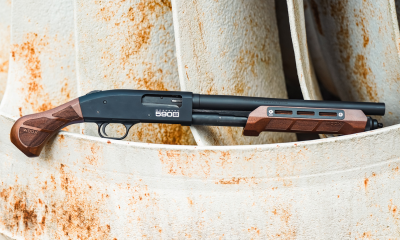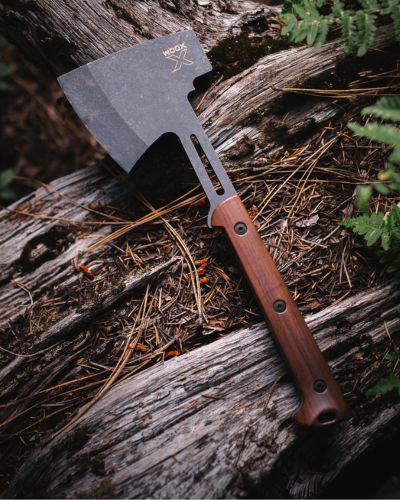Order by December 14 for guaranteed Christmas delivery. Exclusions apply — check the product page for full shipping details.

Order by December 14 for guaranteed Christmas delivery. Exclusions apply — check the product page for full shipping details.
GUN PARTS
AXES
KNIVES

Few more points to ponder when you’re picking an optic (Part 2)
September 24, 2021 4 min read
In the first part of this post, we talked about a few of the things you should consider before you invest in an optic for your rifle. In this installment, we’re going to add a few points to the list.
Eye Relief
Eye relief is the distance your eye must be from the scope to see its full field of view. If you are at the wrong eye relief, you will only see a small circle of light surrounded by blackness.
Standard Eye Relief
Standard eye relief is in the 3-to-4-inch range. Most magnified optics fall in this category. It’s a good choice for medium-caliber rifles that you plan to shoot at medium to long ranges. If you’re shooting something heavier, make sure that you mount your scope as far forward as you can. This will give you enough room so that the scope doesn’t hit you under heavy recoil. The resulting bruise, or even cut, is called “scope eye”. You don’t want to experience it!
Long Eye Relief
Long eye relief scopes are mounted farther forward on the rifle than the standard variety. You will often hear them called “Scout Scopes”. Anything over 4.5 inches is Long Eye Relief. You will use this type of optic in heavy brush areas where you want fast target acquisition for snapshots. Longer eye relief is also desirable in heavier caliber rifles (remember “scope eye”), and when shooting uphill. Shooting uphill tends to shorten the distance between the scope and your eye, risking “scope eye” yet again.

Parallax
Parallax is an optical illusion that makes the target appear out of focus and the crosshairs seem to move off target when your eye moves slightly right or left in the scope’s eyepiece. Most fixed optics used for short-to-medium range have a fixed parallax set to 150 or 200 yards. Consequently, parallax doesn’t become an issue until around 300 yards or so when you’re using a fixed magnification less than 8x.
Parallax can become an issue at higher magnifications, though, especially with variable power scopes. The good news, however, is that most scopes like this have an adjustment for parallax. You simply set the adjustment for whatever range you’re shooting, and you should be good to go. Keep in mind that the numbers on the adjustment dial might not be accurate, so make sure you get in some practice time on the range. This will let you know just what adjustments to make with your chosen load.
Field of View
In both installments of this post, I’ve used the term “Field of View” several times. If you’re wondering what it is, fear not, because I’m about to tell you.
Field of view (FOV) is the area you can see through your scope. FOV is the number of feet visible through the optic at 100 yards. Higher magnification scopes have narrower fields of view. Conversely, low magnification optics have wider fields of view. Therefore, zero magnification optics like red dots and holographic sights are more desirable when fast target acquisition is needed.
First Focal Plane vs Second Focal Plane
Another decision you need to make if you are using a variable-powered optic is if you need a first focal plane reticle (FFP) or a second focal plane (SFP) reticle.
First focal plane reticles appear to grow as you increase magnification. They stay the same size relative to the target. This lets the holdover points remain the same regardless of the magnification setting. The bad part is that the reticle can appear thin and hard to see at lower magnification. It will also appear thick and will seem to cover more of the target at higher settings.
Second focal plane reticles remain the same size regardless of what magnification you are using. In other words, your target will appear to grow as you increase magnification, but your reticle stays the same. On one hand, this gives you an easy to see reticle at lower magnifications. On the other, your holdover points will be calibrated for the highest magnification of the scope and won’t be right at lower settings.

Prism Optics
Conventional scopes use lenses to focus the light gathered by the objective lens. These lenses then transmit that light through the tube and to the eyepiece. Prism scopes, however, use a prism (duh!) to focus that light and transmit it to the eyepiece.
This allows for a more compact design (lengthwise, anyway) than a traditional scope. They come in fixed magnifications from 1x to around 5x. They have adjustable diopters so you can get the focus perfect for your eye, and usually have an etched reticle.
The way these scopes focus light is excellent for people with astigmatism since an illuminated reticle in a prism optic will be sharp and crisp.
How much do you want to spend?
A common statement among shooters is that you should spend at least as much money on your glass as you did on the rifle, if not more. I’m not necessarily convinced that this is an absolute, written in stone, unbreakable commandment. It is, however, illustrative of another old adage- “You get what you pay for.” Let me ask you this: Does it make sense to spend $2,000 on a rifle and then spend $200 on a scope and rings? Let’s not even mention the cost of booking your once-in-a-lifetime hunt, plus travel expenses. How horrible would it be to spend ALL that money, only to blow your one shot at the trophy of a lifetime because you got cheap when it came to a scope?
My advice is to get the highest quality optic you can afford, paired with the best rifle you can afford. Then spend as much ammo as you can afford in becoming proficient with the combination.
I hope these posts gave you some things to mull over when you are considering buying a scope. Did I miss anything? Am I dead wrong about something? I want to know what you think, so please leave a comment below!
Leave a comment
Comments will be approved before showing up.
Also in Woox Journal
The Mossberg Maverick 88: A Working-Man’s Shotgun Raised to a Higher Calling
December 09, 2025 0 min read
Read More
Mossberg Maverick 88 Upgrade: Gladiatore Walnut & Aluminum
December 09, 2025 1 min read
The Mossberg Maverick 88 evolves from rugged workhorse to heirloom-quality shotgun with Gladiatore walnut and aluminum furniture—performance and craftsmanship combined.

Tikka T3x Hunter 16″ with WOOX Cobra Precision Build
October 24, 2025 1 min read
A purpose-driven rifle system blending craftsmanship, precision, and performance—the WOOX Cobra + Tikka T3x Hunter 16″ build is made for the modern outdoorsman.
STICK AROUND AND STAY UPDATED!
Want the latest promotions, expert tips, and a cool sticker set?
Subscribe to our newsletter today.
Spam? Not on our watch!
















